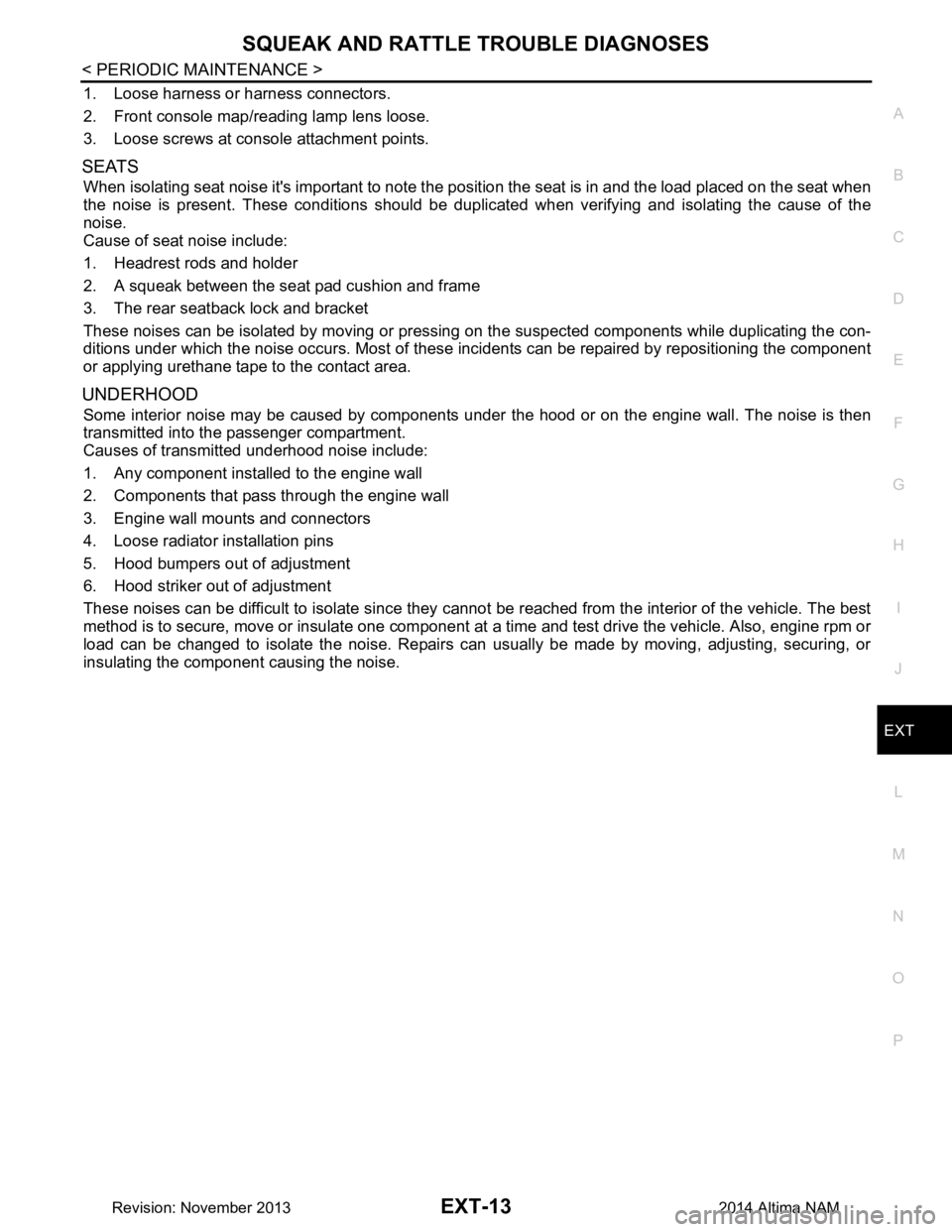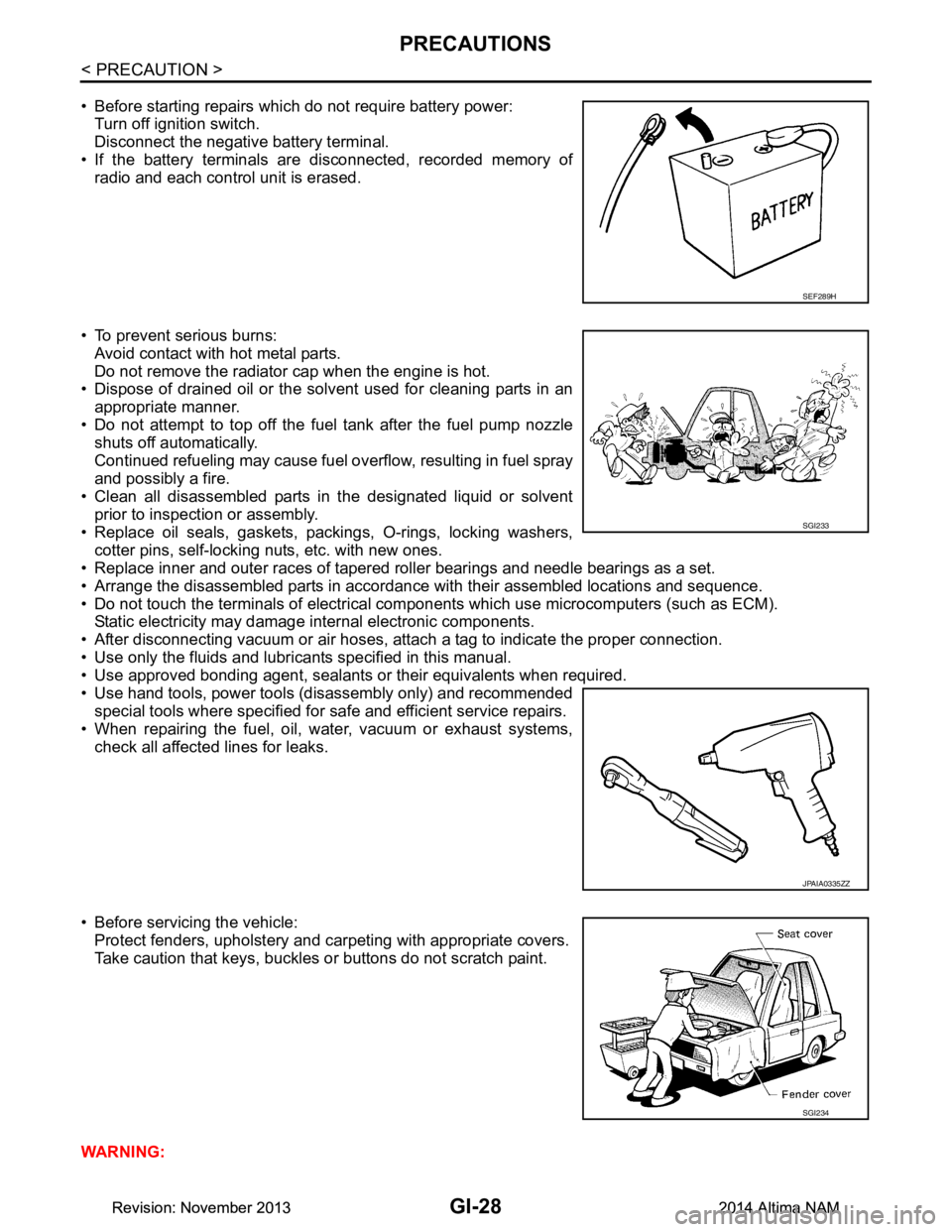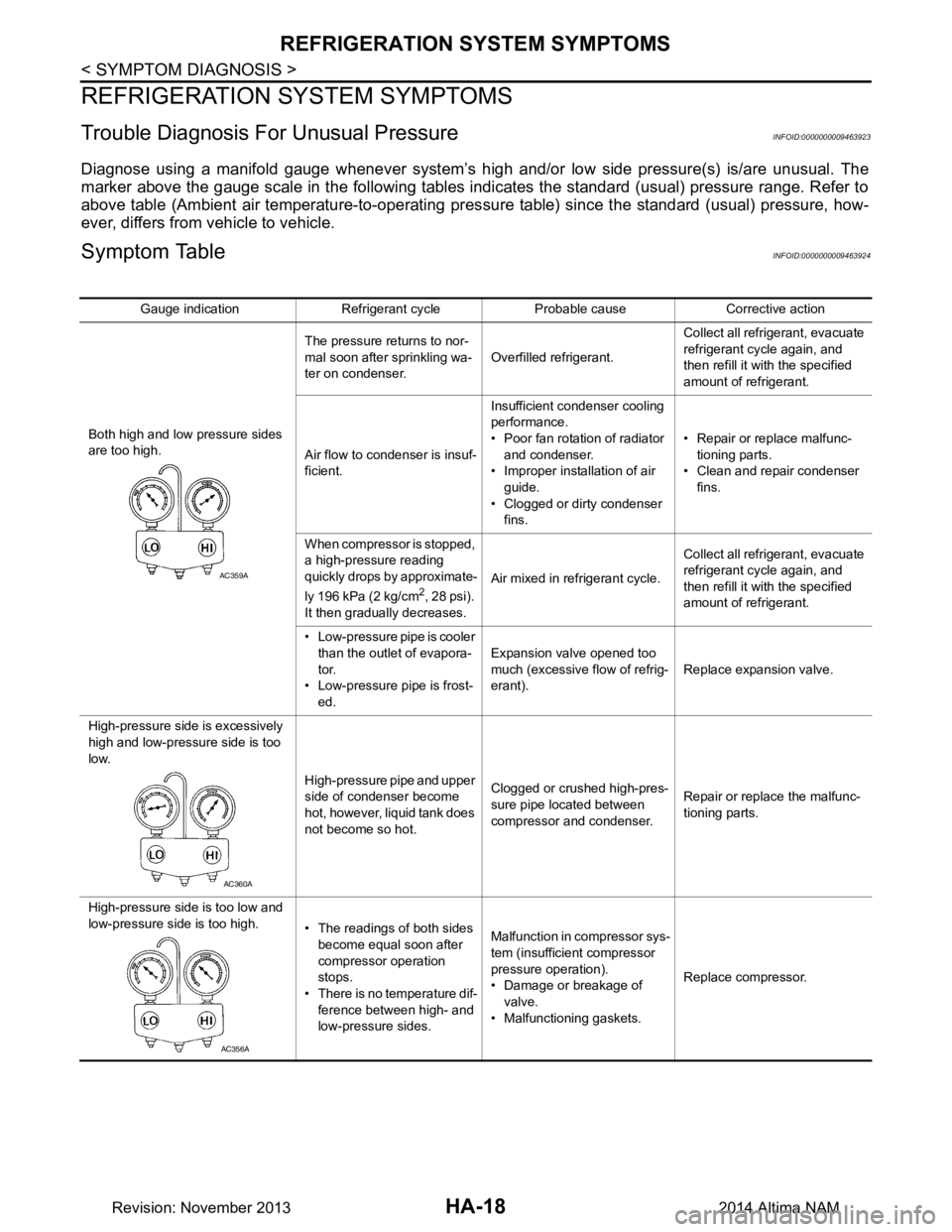2014 NISSAN TEANA radiator
[x] Cancel search: radiatorPage 2173 of 4801
![NISSAN TEANA 2014 Service Manual
FRONT TIMING CHAIN CASEEM-175
< REMOVAL AND INSTALLATION > [VQ35DE]
C
D E
F
G H
I
J
K L
M A
EM
NP
O
REMOVAL
1. Remove engine under cover. Refer to
EXT-28, "Removal and Installation".
2. Drain the NISSAN TEANA 2014 Service Manual
FRONT TIMING CHAIN CASEEM-175
< REMOVAL AND INSTALLATION > [VQ35DE]
C
D E
F
G H
I
J
K L
M A
EM
NP
O
REMOVAL
1. Remove engine under cover. Refer to
EXT-28, "Removal and Installation".
2. Drain the](/manual-img/5/57390/w960_57390-2172.png)
FRONT TIMING CHAIN CASEEM-175
< REMOVAL AND INSTALLATION > [VQ35DE]
C
D E
F
G H
I
J
K L
M A
EM
NP
O
REMOVAL
1. Remove engine under cover. Refer to
EXT-28, "Removal and Installation".
2. Drain the engine coolant from the radiator. Refer to MA-23, "ENGINE COOLANT : Changing Engine Cool-
ant".
3. Drain the engine oil. Refer to MA-27, "ENGINE OIL : Changing Engine Oil"
.
4. Drain the power steering fluid. Refer to ST-30, "Draining and Refilling"
.
5. Remove engine room cover. Refer to EM-143, "Removal and Installation"
.
6. Remove front air duct. Refer to EM-144, "Removal and Installation"
.
7. Remove battery tray. Refer to PG-74, "Removal and Installation (Battery Tray)"
.
8. Remove the hood ledge covers (LH/RH).
9. Remove cowl top and cowl top extension. Refer to EXT-24, "Removal and Installation"
.
10. Remove upper radiator hose.
11. Disconnect engine coolant reservoir hose from t he radiator and remove engine coolant reservoir.
12. Remove cooling fan assembly. Refer to CO-42, "Removal and Installation"
.
13. Disconnect lower radiator hose from engine.
14. Remove the radiator. Refer to CO-41, "Removal and Installation"
.
15. Disconnect the power steering fluid reservoir tank hose from the power steering pump and fluid cooler and
remove the power steering fluid reservoir tank. Refer to ST-38, "Exploded View"
.
16. Remove the front RH wheel and tire. Refer to MA-39, "WHEELS : Adjustment"
.
17. Remove the fender protector side cover (RH). Refer to EXT-26, "FENDER PROTECTOR : Removal and
Installation".
18. Remove the drive belt. Refer to EM-134, "Removal and Installation"
.
19. Remove the rocker covers, if necessary. Refer to EM-168, "Removal and Installation LH"
and EM-169,
"Removal and Installation RH".
NOTE:
Necessary only when removing timing chains.
20. If removing the timing chains, obtain compression TDC of No. 1 cylinder as follows:
a. Rotate crankshaft pulley clockwise to align timing mark (grooved line without color) with timing indicator.
b. Check that intake and exhaust camshaft lobes on No. 1 cylinder (right bank of engine) are located as shown.
• If not, turn the crankshaft one revolution (360 °) and align as
shown.
21. Remove the access plate and lock the ring gear using Tool. CAUTION:
JMBIA1135GB
SEM418G
Tool number : — (J-50288)
Revision: November 20132014 Altima NAM
Page 2215 of 4801
![NISSAN TEANA 2014 Service Manual
ENGINE MOUNTEM-217
< REMOVAL AND INSTALLATION > [VQ35DE]
C
D E
F
G H
I
J
K L
M A
EM
NP
O
ENGINE MOUNT
ENGINE MOUNT (FRONT)
ENGINE MOUNT (FRONT) : Removal and InstallationINFOID:0000000009460578
WARN NISSAN TEANA 2014 Service Manual
ENGINE MOUNTEM-217
< REMOVAL AND INSTALLATION > [VQ35DE]
C
D E
F
G H
I
J
K L
M A
EM
NP
O
ENGINE MOUNT
ENGINE MOUNT (FRONT)
ENGINE MOUNT (FRONT) : Removal and InstallationINFOID:0000000009460578
WARN](/manual-img/5/57390/w960_57390-2214.png)
ENGINE MOUNTEM-217
< REMOVAL AND INSTALLATION > [VQ35DE]
C
D E
F
G H
I
J
K L
M A
EM
NP
O
ENGINE MOUNT
ENGINE MOUNT (FRONT)
ENGINE MOUNT (FRONT) : Removal and InstallationINFOID:0000000009460578
WARNING:
• Situate the vehicle on a flat and solid surface.
• Place chocks at front and back of rear wheels.
• Always work safely.
• Do not start work until the engine an d exhaust system are cooled completely.
CAUTION:
Do not damage or spill oil on the engine mount insulator (front).
NOTE:
When removing components such as hoses, tubes/lines, etc. , cap or plug openings to prevent fluid from spill-
ing.
REMOVAL
1. Remove the air cleaner assembly, front air duct, and air duct hose and resonator assembly. Refer to EM-
144, "Removal and Installation".
2. Remove the battery and battery tray assembly. Refer to PG-74, "Removal and Installation (Battery Tray)"
.
3. Remove the engine under cover. Refer to EXT-28, "Removal and Installation"
.
4. Remove the fender protector side covers (RH/LH). Refer to EXT-26, "FENDER PROTECTOR : Removal
and Installation".
5. Partially remove the fender protectors (RH/LH). Refer to EXT-26, "FENDER PROTECTOR : Removal and
Installation".
6. Remove the radiator. Refer to CO-41, "Removal and Installation"
.
7. Remove the cooling fan shroud and motor assembly. Refer to CO-42, "Removal and Installation"
.
8. Remove the exhaust manifold heat shield (LH). Refer to EM-153, "Removal and Installation (RH)"
.
9. Support the engine (1) and transaxle (2) using a suitable jack (A) as shown.
CAUTION:
• Position a suitable jack under the engine and transaxle
assembly as shown.
• Do not damage the front exhau st tube or transaxle oil pan
with the jack.
10. Disconnect the engine mounting insulator (front) vacuum hose.
11. Remove the engine mounting insulator (front) nut (A).
ALBIA0894GB
AWBIA1241GB
Revision: November 20132014 Altima NAM
Page 2219 of 4801
![NISSAN TEANA 2014 Service Manual
ENGINE ASSEMBLYEM-221
< UNIT REMOVAL AND INSTALLATION > [VQ35DE]
C
D E
F
G H
I
J
K L
M A
EM
NP
O
• Do not damage the edge of the crankshaft
position sensor (POS) or the ring gear teeth.
REMOVAL
NISSAN TEANA 2014 Service Manual
ENGINE ASSEMBLYEM-221
< UNIT REMOVAL AND INSTALLATION > [VQ35DE]
C
D E
F
G H
I
J
K L
M A
EM
NP
O
• Do not damage the edge of the crankshaft
position sensor (POS) or the ring gear teeth.
REMOVAL](/manual-img/5/57390/w960_57390-2218.png)
ENGINE ASSEMBLYEM-221
< UNIT REMOVAL AND INSTALLATION > [VQ35DE]
C
D E
F
G H
I
J
K L
M A
EM
NP
O
• Do not damage the edge of the crankshaft
position sensor (POS) or the ring gear teeth.
REMOVAL
NOTE:
When removing components such as hoses, tubes/lines, etc. , cap or plug openings to prevent fluid from spill-
ing.
1. Remove hood assembly. Refer to DLK-170, "HOOD ASSEMBLY : Removal and Installation"
.
2. Release fuel pressure. Refer to FL-5, "Inspection"
.
3. Drain engine coolant. Refer to CO-36, "Changing Engine Coolant"
.
4. Drain power steering fluid. Refer to ST-30, "Draining and Refilling"
.
5. Remove front wheels and tires (RH/LH). Refer to WT-55, "Adjustment"
.
6. Remove fender protector side covers (RH/LH). Refer to EXT-26, "FENDER PROTECTOR : Removal and
Installation".
7. Remove the engine under cover. Refer to EXT-17, "Removal and Installation"
.
8. Remove the engine room cover. Refer to EM-143, "Removal and Installation"
.
9. Remove air duct hose and resonator assembly and air cleaner case assembly with mass air flow sensor.
Refer to EM-144, "Removal and Installation"
.
10. Remove battery and battery tray. Refer to PG-74, "Removal and Installation (Battery Tray)"
.
11. Remove transmission control module. Refer to TM-183, "Removal and Installation"
.
12. Remove cowl top. Refer to EXT-24, "Removal and Installation"
.
13. Remove strut brace using power tools. Refer to FSU-19, "Exploded View"
.
14. Remove IPDM E/R. Refer to PCS-32, "Removal and Installation"
.
15. Remove the following parts: • EVAP vacuum hose
• Brake booster vacuum hose
• Heater hoses (engine side)
16. Disconnect transaxle shift control cables. Refer to TM-380, "Removal and Installation"
.
17. Remove upper and lower radiator hoses.
18. Disconnect CVT fluid cooler hoses.
19. Remove power steering reservoir, suction hose and high pressure hose.
20. Disconnect fuel hose quick connection at vehicle piping side. Refer to EM-163, "Removal and Installa-
tion".
21. Remove the front exhaust tube using power tools. Refer to EX-10, "Exploded View"
.
22. Discharge and recover the R134a refrigerant. Refer to HA-23, "Recycle Refrigerant"
.
23. Remove the A/C compressor using power tools. Refer to HA-30, "COMPRESSOR : Removal and Installa-
tion".
24. Install engine slingers into front of LH cylinder head and rear of RH cylinder head.
• (A): RH cylinder head
ALBIA0262GB
Revision: November 20132014 Altima NAM
Page 2427 of 4801

SQUEAK AND RATTLE TROUBLE DIAGNOSESEXT-13
< PERIODIC MAINTENANCE >
C
D E
F
G H
I
J
L
M A
B
EXT
N
O P
1. Loose harness or harness connectors.
2. Front console map/reading lamp lens loose.
3. Loose screws at console attachment points.
SEATS
When isolating seat noise it's important to note the pos ition the seat is in and the load placed on the seat when
the noise is present. These conditions should be duplic ated when verifying and isolating the cause of the
noise.
Cause of seat noise include:
1. Headrest rods and holder
2. A squeak between the seat pad cushion and frame
3. The rear seatback lock and bracket
These noises can be isolated by moving or pressing on the suspected components while duplicating the con-
ditions under which the noise occurs. Most of thes e incidents can be repaired by repositioning the component
or applying urethane tape to the contact area.
UNDERHOOD
Some interior noise may be caused by components under the hood or on the engine wall. The noise is then
transmitted into the passenger compartment.
Causes of transmitted underhood noise include:
1. Any component installed to the engine wall
2. Components that pass through the engine wall
3. Engine wall mounts and connectors
4. Loose radiator installation pins
5. Hood bumpers out of adjustment
6. Hood striker out of adjustment
These noises can be difficult to isolate since they cannot be reached from the interior of the vehicle. The best
method is to secure, move or insulate one component at a time and test drive the vehicle. Also, engine rpm or
load can be changed to isolate the noise. Repairs can usually be made by moving, adjusting, securing, or
insulating the component causing the noise.
Revision: November 20132014 Altima NAM
Page 2556 of 4801

GI-28
< PRECAUTION >
PRECAUTIONS
• Before starting repairs which do not require battery power:Turn off ignition switch.
Disconnect the negative battery terminal.
• If the battery terminals are disconnected, recorded memory of
radio and each control unit is erased.
• To prevent serious burns: Avoid contact with hot metal parts.
Do not remove the radiator cap when the engine is hot.
• Dispose of drained oil or the solvent used for cleaning parts in an
appropriate manner.
• Do not attempt to top off the fuel tank after the fuel pump nozzle
shuts off automatically.
Continued refueling may cause fuel overflow, resulting in fuel spray
and possibly a fire.
• Clean all disassembled parts in the designated liquid or solvent
prior to inspection or assembly.
• Replace oil seals, gaskets, packings, O-rings, locking washers, cotter pins, self-locking nuts, etc. with new ones.
• Replace inner and outer races of tapered roller bearings and needle bearings as a set.
• Arrange the disassembled parts in accordance with their assembled locations and sequence.
• Do not touch the terminals of electrical com ponents which use microcomputers (such as ECM).
Static electricity may damage internal electronic components.
• After disconnecting vacuum or air hoses, atta ch a tag to indicate the proper connection.
• Use only the fluids and lubricants specified in this manual.
• Use approved bonding agent, sealants or their equivalents when required.
• Use hand tools, power tools (disassembly only) and recommended special tools where specified for safe and efficient service repairs.
• When repairing the fuel, oil, water, vacuum or exhaust systems,
check all affected lines for leaks.
• Before servicing the vehicle: Protect fenders, upholstery and carpeting with appropriate covers.
Take caution that keys, buckles or buttons do not scratch paint.
WARNING:
SEF289H
SGI233
JPAIA0335ZZ
SGI234
Revision: November 20132014 Altima NAMRevision: November 20132014 Altima NAM
Page 2588 of 4801

GW-8
< SYMPTOM DIAGNOSIS >
SQUEAK AND RATTLE TROUBLE DIAGNOSES
1. Loose harness or harness connectors.
2. Front console map/reading lamp lens loose.
3. Loose screws at console attachment points.
SEATS
When isolating seat noise it's important to note the pos ition the seat is in and the load placed on the seat when
the noise is present. These conditions should be dupl icated when verifying and isolating the cause of the
noise.
Cause of seat noise include:
1. Headrest rods and holder
2. A squeak between the seat pad cushion and frame
3. The rear seatback lock and bracket
These noises can be isolated by moving or pressing on the suspected components while duplicating the con-
ditions under which the noise occurs. Most of thes e incidents can be repaired by repositioning the component
or applying urethane tape to the contact area.
UNDERHOOD
Some interior noise may be caused by components under the hood or on the engine wall. The noise is then
transmitted into the passenger compartment.
Causes of transmitted underhood noise include:
1. Any component installed to the engine wall
2. Components that pass through the engine wall
3. Engine wall mounts and connectors
4. Loose radiator installation pins
5. Hood bumpers out of adjustment
6. Hood striker out of adjustment
These noises can be difficult to isolate since they cannot be reached from the interior of the vehicle. The best
method is to secure, move or insulate one component at a time and test drive the vehicle. Also, engine rpm or
load can be changed to isolate the noise. Repairs can usually be made by moving, adjusting, securing, or
insulating the component causing the noise.
Revision: November 20132014 Altima NAM
Page 2624 of 4801

HA-18
< SYMPTOM DIAGNOSIS >
REFRIGERATION SYSTEM SYMPTOMS
REFRIGERATION SYSTEM SYMPTOMS
Trouble Diagnosis For Unusual PressureINFOID:0000000009463923
Diagnose using a manifold gauge whenever system’s high and/or low side pressure(s) is/are unusual. The
marker above the gauge scale in the following tables indicates the standard (usual) pressure range. Refer to
above table (Ambient air temperature-to-operating pres sure table) since the standard (usual) pressure, how-
ever, differs from vehicle to vehicle.
Symptom TableINFOID:0000000009463924
Gauge indication Refrigerant cycle Probable cause Corrective action
Both high and low pressure sides
are too high. The pressure returns to nor-
mal soon after sprinkling wa-
ter on condenser. Overfilled refrigerant. Collect all refrigerant, evacuate
refrigerant cycle again, and
then refill it with the specified
amount of refrigerant.
Air flow to condenser is insuf-
ficient. Insufficient condenser cooling
performance.
• Poor fan rotation of radiator and condenser.
• Improper installation of air
guide.
• Clogged or dirty condenser fins. • Repair or replace malfunc-
tioning parts.
• Clean and repair condenser
fins.
When compressor is stopped,
a high-pressure reading
quickly drops by approximate-
ly 196 kPa (2 kg/cm
2, 28 psi).
It then gradually decreases. Air mixed in refrigerant cycle.
Collect all refrigerant, evacuate
refrigerant cycle again, and
then refill it with the specified
amount of refrigerant.
• Low-pressure pipe is cooler than the outlet of evapora-
tor.
• Low-pressure pipe is frost- ed. Expansion valve opened too
much (excessive flow of refrig-
erant). Replace expansion valve.
High-pressure side is excessively
high and low-pressure side is too
low.
High-pressure pipe and upper
side of condenser become
hot, however, liquid tank does
not become so hot. Clogged or crushed high-pres-
sure pipe located between
compressor and condenser. Repair or replace the malfunc-
tioning parts.
High-pressure side is too low and
low-pressure side is too high. • The readings of both sides
become equal soon after
compressor operation
stops.
• There is no temperature dif- ference between high- and
low-pressure sides. Malfunction in compressor sys-
tem (insufficient compressor
pressure operation).
• Damage or breakage of
valve.
• Malfunctioning gaskets. Replace compressor.
AC359A
AC360A
AC356A
Revision: November 20132014 Altima NAM
Page 2806 of 4801
![NISSAN TEANA 2014 Service Manual
INSUFFICIENT HEATINGHAC-157
< SYMPTOM DIAGNOSIS > [MANUAL AIR CONDITIONER]
C
D E
F
G H
J
K L
M A
B
HAC
N
O P
INSUFFICIENT HEATING
Component Function CheckINFOID:0000000009463224
SYMPTOM: Insufficie NISSAN TEANA 2014 Service Manual
INSUFFICIENT HEATINGHAC-157
< SYMPTOM DIAGNOSIS > [MANUAL AIR CONDITIONER]
C
D E
F
G H
J
K L
M A
B
HAC
N
O P
INSUFFICIENT HEATING
Component Function CheckINFOID:0000000009463224
SYMPTOM: Insufficie](/manual-img/5/57390/w960_57390-2805.png)
INSUFFICIENT HEATINGHAC-157
< SYMPTOM DIAGNOSIS > [MANUAL AIR CONDITIONER]
C
D E
F
G H
J
K L
M A
B
HAC
N
O P
INSUFFICIENT HEATING
Component Function CheckINFOID:0000000009463224
SYMPTOM: Insufficient heating
INSPECTION FLOW
1. CONFIRM SYMPTOM BY PERFORMING OP ERATION CHECK - TEMPERATURE INCREASE
1. Turn temperature control dial clockwise to maximum heat.
2. Check for hot air at discharge air outlets.
Can a symptom be duplicated?
YES >> GO TO 3
NO >> GO TO 2
2. CHECK FOR ANY SYMPTOMS
Perform a complete operational check and check for any symptoms. Refer to HAC-140, "Work Procedure"
.
Does another symptom exist?
YES >> Refer to HAC-154, "Symptom Table".
NO >> System OK.
3. CHECK FOR SERVICE BULLETINS
Check for any service bulletins.
>> GO TO 4
4. CHECK ENGINE COOLING SYSTEM
1. Check for proper engine coolant level. Refer to CO-11, "System Inspection"
(QR25DE) or CO-35, "System
Inspection" (VQ35DE).
2. Check hoses for leaks or kinks.
3. Check radiator cap. Refer to CO-11, "System Inspection"
(QR25DE) or CO-35, "System Inspection"
(VQ35DE).
4. Check for air in cooling system.
>> GO TO 5
5. CHECK AIR MIX DOOR MOTOR OPERATION
Check and verify air mix door mechanism for smooth operation.
Does air mix door operate correctly?
YES >> GO TO 6
NO >> Check the air mix door motor circuit. Refer to HAC-144, "Diagnosis Procedure"
.
6. CHECK AIR DUCTS
Check for disconnected or leaking air ducts.
Is the inspection result normal?
YES >> GO TO 7
NO >> Repair all disconnected or leaking air ducts.
7. CHECK HEATER HOSE TEMPERATURES
1. Start engine and warm it up to normal operating temperature.
2. Touch both the inlet and outlet heater hoses. The inlet hose should be hot and the outlet hose should be
warm.
Is the inspection result normal?
YES >> GO TO 8
NO >> Both hoses warm: GO TO 9
8. CHECK ENGINE COOLANT SYSTEM
Revision: November 20132014 Altima NAMRevision: November 20132014 Altima NAM